On the 4 May 1864 we crossed the Rapidan River, and headed towards the Wilderness Tavern, the convergence point for our Corps, prior to heading south into the open terrain beyond on our march to Richmond… Prior to this march I had taken the decision to permanently disband the 20th Indiana (a somewhat problematic regiment for me at the best of times), its remaining men were sent to the 6th New Jersey as replacements. However the wily Robert E. Lee launched a rapid and unexpected counter attack on us the next day (5 May) and we were taken by surprise. My Division, being near the forefront, was rapidly deployed on what suitable ground could be found to hold the line while the rest of the army moved up into battle formation.
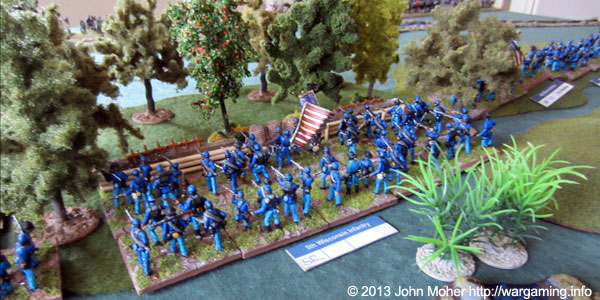
We found ourselves defending a line based around some low rolling hills. These hills were intersected by a stream and swampy marsh, and to the front was some woodland (one of the few patches of proper trees in the whole Virginia Wilderness). This was one of the few areas with any notably open ground, and as a result there was also some crops from some determined homesteader who had hacked out a small farm within this wild terrain.
Having a large complement of artillery I deployed this on the 2 main hills commanding the best fields of fire, the L/1st Ohio, and A/Maryland batteries were on my left, and the 2/New Jersey battery on my right. The new reinforcements, the 5th Wisconsin, I had entrench in the wood line between the two hills to anchor my position, and then distributed my veteran infantry on both sides of their positions connecting them to the artillery. The 3rd Pennsylvania Cavalry were on my extreme left to cover the most open ground on my flank, and I detached the much depleted 54th Massachusetts (Coloured) Infantry into a small copse on my far right to prevent it being used by the enemy to flank my position.
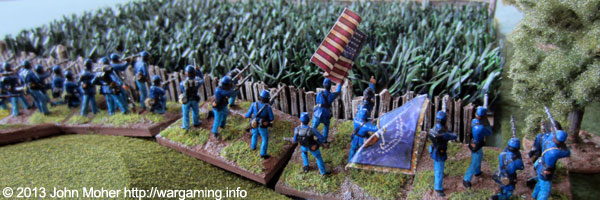
The infantry were deployed in a battle line in advance of the crest line where the artillery was deployed, utilising additional terrain to strengthen their position (the fences of the crop fields on the left and the crest of a second smaller hill on the right), and while this appeared an improved deployment to being along the crest of the main hill line, in hindsight it is likely it weakened our defensive position significantly.
The enemy soon appeared, advancing rapidly. To my chagrin there was no opposition on my left, and a strong column of enemy infantry & cavalry closing on my right. A stream meandered across some distance in front of my position on m right, and the Confederate forces rapidly forced their crossing, despite the disorder it caused, and were soon closing on my line – the cavalry brigade (2nd & 4th Virginia Cavalry) closing especially rapidly on the 2/New Jersey Artillery Battery around the flank of my main infantry battle line. The artillery immediately opened a bombardment on the cavalry, and I ordered redeployments in response to this advance; the 1st Minnesota on the artillery’s left (my reserve infantry) wheeling forward to enfilade the cavalry, and the artillery and cavalry on the far left limbering up and preparing to redeploy to the centre & right to form a new reserve line… To cover this latter move the 6th New Jersey Infantry advanced through the crop field to screen my left as far forward as possible, while the 69th New York began a move across the front of the 5th Wisconsin’s entrenchments to flank the attacking enemy infantry columns.
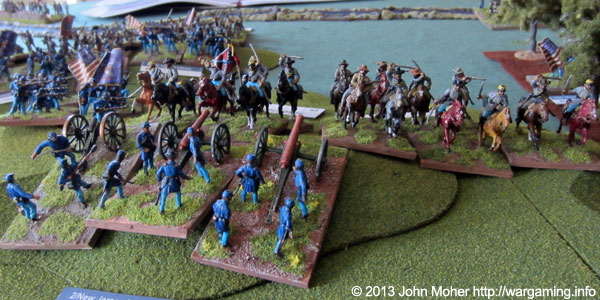
And then they were on us, the 2nd & 4th Virginia Cavalry smashed into the 2/New Jersey Artillery without a single volley of canister hitting them, and rode down the entire battery – barely a gunner survived! The 9th South Carolina smashed into the depleted 4th Vermont, and the 11th Virginia & 14th North Carolina into the 4th Maine! While the handful of Vermont veterans staunchly through back they numerically superior 9th South Carolinas (they were out-numbered more than 3:1), the 4th Maine (outnumbered 2:1) was not able to do likewise, and was thrown back from the forward hill to the main one with heavy casualties – my line had been broken in the first combat.
We rapidly continued to redeploy as best as possible, keeping up a furious fusillade of musketry against the confederates, and on the extreme right I ordered the 54th Massachusetts to begin a withdrawal, so they did not become isolated (and to avoid the 1st Texas Infantry bearing down on them and 3 times their number)! The 4th Vermont were now semi isolated, and could not easily retire, so they held their small piece of high ground and bravely stood fast to the rest of our benefit. On my left the artillery and cavalry began their move to the right, and the 69th New York was now in position to sweep through the wood. However more enemy were present opposite my centre (but beyond the stream that ran laterally from my right), consisting of 2 infantry regiments and some artillery, although they showed no interest in advancing and appeared to be acting solely as a flank guard.
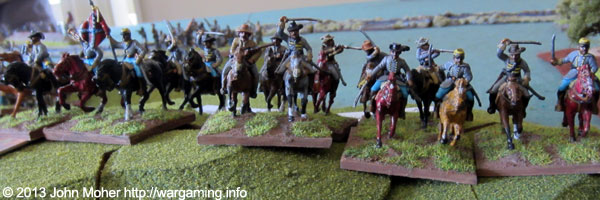
The Rebs continued their aggressive advance and their infantry charged again in the centre again despite our redeployments, The 4th Vermont were finally overrun and destroyed, while the 1st Minnesota suffering heavy casualties as they attempted to crest the main hill on my right, the Confederate infantry endeavouring to join their cavalry who already held the crest amongst our abandoned artillery pieces… (Casualties favoured the Confederates 10 to 7 at this point).
While the 1st Minnesota began rapidly trying to improvise defensive works on the hill crest, the 69th New York finished their move through the woods and closed on the flank of the 14th North Carolina. However the enemy responded by sending the 10th Alabama forward in the centre, to in turn take the 69th New York in the flank! In the centre the 5th Wisconsin had begun a movement to their right flank to try and re-establish the original line that had now been dispersed, and around the swampy marsh and stream in my centre rear the 3rd Pennsylvania Cavalry and my remaining artillery battled to get to the right.
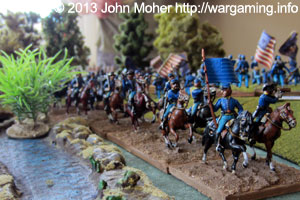
Another wave of enemy assaults came in, hitting all along the line, including the 3rd Pennsylvania Cavalry (who were still in column as there was no room for them to deploy). We were unable to repel any of these assaults – the 1st Minnesota were completely overrun in their temporary entrenchments, and the 3rd Pennsylvania Cavalry took very heavy casualties from the opposing horsemen. The 69th New York was also completely broken in the wood, and the enemy carried almost all of our positions (casualties now favoured the Confederates 20 to 7). My division was exhausted, and shortly after we fell back rapidly abandoning the high ground to the enemy… However the Confederates had lost some Heroic Leaders, including Colonel Samuel Garland, Jr (11th Virginia) & the Colonel of the 9th South Carolina.
As my division limped away from the battle it looked something like this:
- The “Fighting Sixty-Ninth” 69th New York – dispersed, attempting to reform
- 4th “Magnificent” Maine (Strength 3; Old Reliable’s)
- 6th New Jersey/20th Indiana (Strength 3; Veteran)
- 2nd New Hampshire (Strength 2; Veteran)
- 4th Vermont – dispersed, attempting to reform
- 54th “Unstoppable” Massachusetts (Coloured) (Strength 2; Veteran)
- 1st Minnesota – dispersed, attempting to reform
- 5th Wisconsin Infantry Regiment (Strength 10)
- 3rd Pennsylvania Cavalry Regiment (Strength 3)
- Battery L, 1st Ohio Light Artillery (2 x Rifles)
- Battery 2, New Jersey Light Artillery – overrun, battery destroyed
- Battery A, Maryland Light Artillery (2 x Napoleons; 1 x Howitzer)
- Victory Points Earned: 2
Meanwhile Major General Longman’s Confederate force occupied the position in the following state:
- 11th Virginia “RWTP” (Strength 6; Veteran; Old Reliable’s; Sharpshooters)
- 10th Alabama (Strength 4; Veteran)
- 9th South Carolina (Strength 6; Veteran)
- 14th North Carolina (Strength 3; Veteran; Hero)
- 14th Louisiana (Strength 3; Veteran)
- 1st Texas (Strength 4)
- 2nd Virginia “Lynchburg Cougars” Cavalry (Strength 3)
- 4th Virginia “Deadly On 2 Legs” Cavalry (Strength 5; Veteran)
- “Lynchburg” Artillery Battery (1 x Napoleon)
- Victory Points Earned: 7
The Battle For The Wilderness raged for another day, before our commander General Grant, disengaged and moved around the enemy, continuing his plans to advance on Richmond.
















dear oh dear, I can see the papers in Richmond after that, guess longman is up for another promotion for that effort 😉
At this rate you will barely rate a footnote in Longman’s acclaimed Civil War memoirs
lol
I hope next time you can get some larger units so you can have some staying power and able to inflict more casualties
cheers
Oddly enough… 😉 (see the next blog post).
Yep. But maybe some thanks for contributing to his glory & success…
Yep – in fact we’ve been discussing the combat power factors/relativeness (is that a word?) of small units versus large. Especially if the large units are in that deep field-column-like formation that Longman (Cam) used, which isn’t very ACW-ish AFAIK (they manoeuvred in ‘columns of divisions’ or such occasionally but never actually fought that way – always deploying into line for any combat).
Ultimately though I thought my deployment was quite strong – but in hindsight it was very weak. I wasted my strongest unit in no-mans-land and left the rest of my forces unable to support each other. I should have entrenched the the 5th Wisconsin on the crest-line of the main hill on one side and done similar with the 1st Minnesota on the other, then deployed the artillery supporting those units and flanked by my next strongest Infantry. The remaining infantry would then be in reserve with one small unit to contest the central wood if needed, and my cavalry forming a third line in the centre to provide a fast way to get extra troops to the key spot before dismounting (e.g. if deployed back behind the hills next to the stream they could have happily forded the stream and dealt with the disorder at my leisure and at much less risk than what actually ended up happening)..
Essentially the crop field and small hill in front of the 2 big hills turned out to be red herrings, and utilising that terrain actually weakened my position (very much like Sickles at Gettysburg with the Peach orchard, etc), and I’d have been in a much better position sitting back and digging in on the main heights (which were ultimately the objectives of the Confederate Attack).
🙂